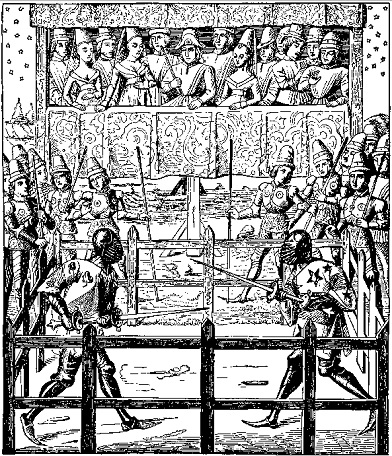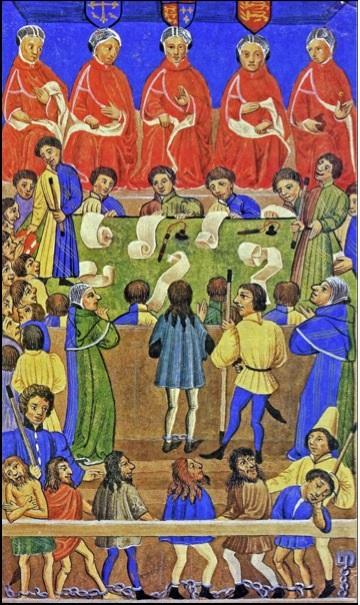
King Henry II – rule by law

Introduction – Henry II and the Law
Before the reign of Henry II, most law cases were decided by the local lord, and only the most serious cases were tried by the king himself. Henry changed this. About 1176, he set up the 'General Eyre' – judges who went round the country holding courts called 'assizes'. He also began to use juries, rather than 'trial by ordeal'.
It is worth remembering that Henry II's clash with Thomas à Becket was about the right of the king to try criminal priests in the royal courts.
At the end of the reign, Henry's Chief Justiciar Ranulf de Glanvill published a set of 14 books called the Treatise on the Laws and Customs of England. It was revolutionary not just because it defined for the first time the legal system of England, but because it stated that justice and peace were the duties of the king. On it all the laws of England are based.
Henry's changes to the legal system are arguably the most important development in the whole history of England. By them, he changed the nature of government. He had accepted that the king had a duty (to provide good law and order). But – by taking away the right of barons to try law cases – he had also hugely increased the power of the king.
Study this webpage, then answer the question sheet by clicking on the 'Time to Work' icon at the top of the page.
Links:
The following websites will help you research further:
The Reign of Henry II:
• Short biography on the
BBC website
• Old textbook
account in
SB Harding,
The Story of England (1909)
• Clip from the 1968 film:
The Lion in Winter - Henry evaluates his life • The HistoryTeachers do
Eleanor of Aquitaine ![]()
1 Trial by Ordeal
Before Henry II, people believed in 'trial by ordeal'.
• Sometimes, a man had to fight the man he accused ('trial by combat'); he won his case only if he won the battle.
• Sometimes,a man might be told to hold a piece of hot iron; if the burn did not heal quickly, he was found guilty.
• In 'trial by water', the accused was tied up and thrown into a pond or a river; if he floated, he was guilty.
Henry did not abolish trial by ordeal, but after his reign it was gradually replaced by trials with juries.
This illustration is from an 1909 school textbook by SB Harding.

2 Trial by Judges
The Court of King's Bench about 1460. You can see the five judges; the clerks (taking notes), their pens and inkpots; the accused man; the ushers (who kept order – can you see their staffs); the other criminals awaiting trial; and the jury.
In the Middle Ages, the judge decided whether a person was innocent or guilty. The jury simply acted as witnesses, telling the judges whether they thought the accused was guilty or not. (It was, however, still a fairer system than trial by ordeal.)

... continued – Henry II's Government
Henry II (1154-89) ruled an empire which stretched from the north of England to the south of France. He constantly travelled his empire, surrounded by his court ... which included barons and bishops, along with officials, clerks, servants, prostitutes, horses and hunting dogs. Whilst the was elsewhere in his empire, the country was administered by 'justiciars', many of whom were 'new men' – minor nobles whom he promoted, and who owed everything to the king.
Henry kept power by a mixture of patronage (giving land and honours), and 'anger and ill-will' (which terrified his courtiers). But he failed in his clash with Thomas à Becket; and he could not control his family – in 1173-74 he faced the 'Great Revolt', led by his wife and three of his sons, together with invasions by the rulers of Scotland, Flanders and Boulogne, and a rebellion by a number of barons. It took Henry 18 months to defeat the rebels.
3 Evaluation of Henry II
This was the conclusion by the British historian SB Harding in The Story of England (1909):
Henry died, muttering at the last these words: "Shame, shame, on a conquered King."
Though Henry II died in despair, his life was not unsuccessful. He was indeed selfish, and harsh, and often he was violent in his deeds. Yet his reign was a great benefit to England, and he deserves to rank among the greatest of her kings. He kept down the rebellious nobles, restored order in the government, and introduced reforms into the administration of justice; and the benefits of his rule have continued to the present day.
4 Another Evaluation of Henry II (by James Goldman)
The Lion in Winter is a 1968 historical drama film, written by the American playwright James Goldman.
The film is the story of an imaginary family get-together of Henry, Eleanor and their sons in 1183, when they talk about their lives and their quarrels. You can see here the clip in which Henry reflects on his own life.
It is important that you realise that Henry never said this – they are words put into his mouth by Goldman, and are therefore Goldman's interpretation of Henry's achievments.
Henry: "My life, when it is written, will read better than it lived:
" Henry Fitz-Empress, first Plantagenet, a king at twenty-one, the ablest soldier of an able time. He led men well, he cared for justice when he could, and ruled for thirty years a state as great as Charlemagne's.
He married, out of love, a woman out of legend. Not in Alexandria, or Rome, or Camelot has there been such a queen.
She bore him many children. But no sons. King Henry had no sons. He had three whiskered things but he disowned them."